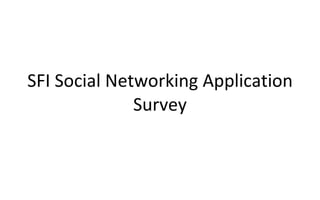Social Network Software - Q3 2009
- 1. SFI Social Networking Application Survey
- 2. What are ŌĆ£Social ▒Ę▒│┘Ę╔┤Ū░∙░ņ▓§ŌĆØ
- 3. Powerlaws Social Networks are ŌĆ£scale freeŌĆØ
- 4. Graph Complexity Social graphs are key graphs, but there are other graphs, layered and intermingled with the social graphs
- 5. Nodes Hubs and Links Node Hub Link
- 6. Links have attributes Node Node Feedback Distance or Decay Intelligence Link Attributes
- 8. Key Graphs
- 9. ELGG SWOT
- 10. Saywire SWOT
- 12. Buddypress / Wordpress MU
Editor's Notes
- Social Networks are contextual sharing engines that use a social-circles network model aka ŌĆ£social graphŌĆØ
- Cite: Albert-L├Īszl├│ Barab├Īsi Social Networks are ŌĆ£scale freeŌĆØ which means that the associations are based on a power law or Pareto distribution
- Scale free networks have three components: Nodes, Hubs (collections of Nodes) and links.
- Links have qualitative properties
- Google Pagerank is an example of qualitative intelligence Mathematical PageRanks (out of 100) for a simple network (PageRanks reported by Google are rescaled logarithmically). Page C has a higher PageRank than Page E, even though it has fewer links to it; the link it has is of a much higher value. A web surfer who chooses a random link on every page (but with 15% likelihood jumps to a random page on the whole web) is going to be on Page E for 8.1% of the time. (The 15% likelihood of jumping to an arbitrary page corresponds to a damping factor of 85%.) Without damping, all web surfers would eventually end up on Pages A, B, or C, and all other pages would have PageRank zero. Page A is assumed to link to all pages in the web, because it has no outgoing links.
- The different software available has biases towards the ŌĆ£KeyŌĆØ graph managed by the tools. Fos SFI, Hub-centric graphs are the appropriate solution, since the SFI content is the Hub.
- ELGG Software
- Saywire Application Service Provider
- Open Journal Peer-review community software
- New Kid on the block, Buddypress/Wordpress MU












